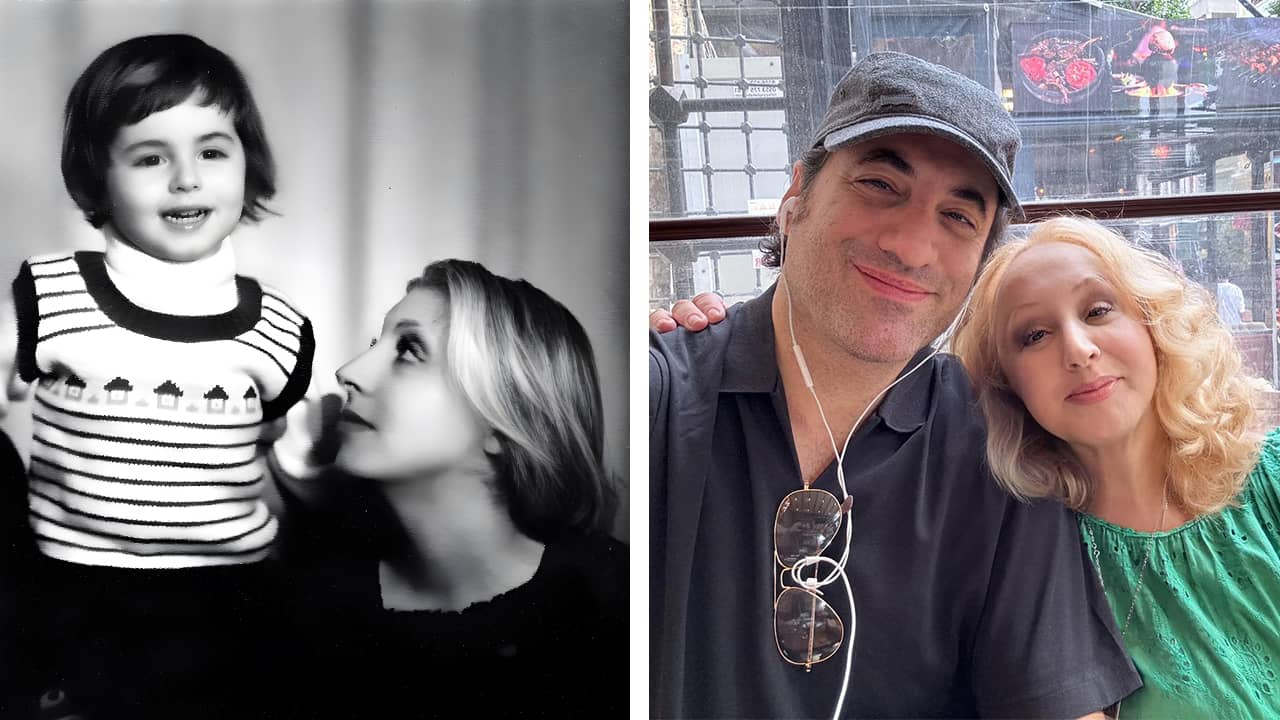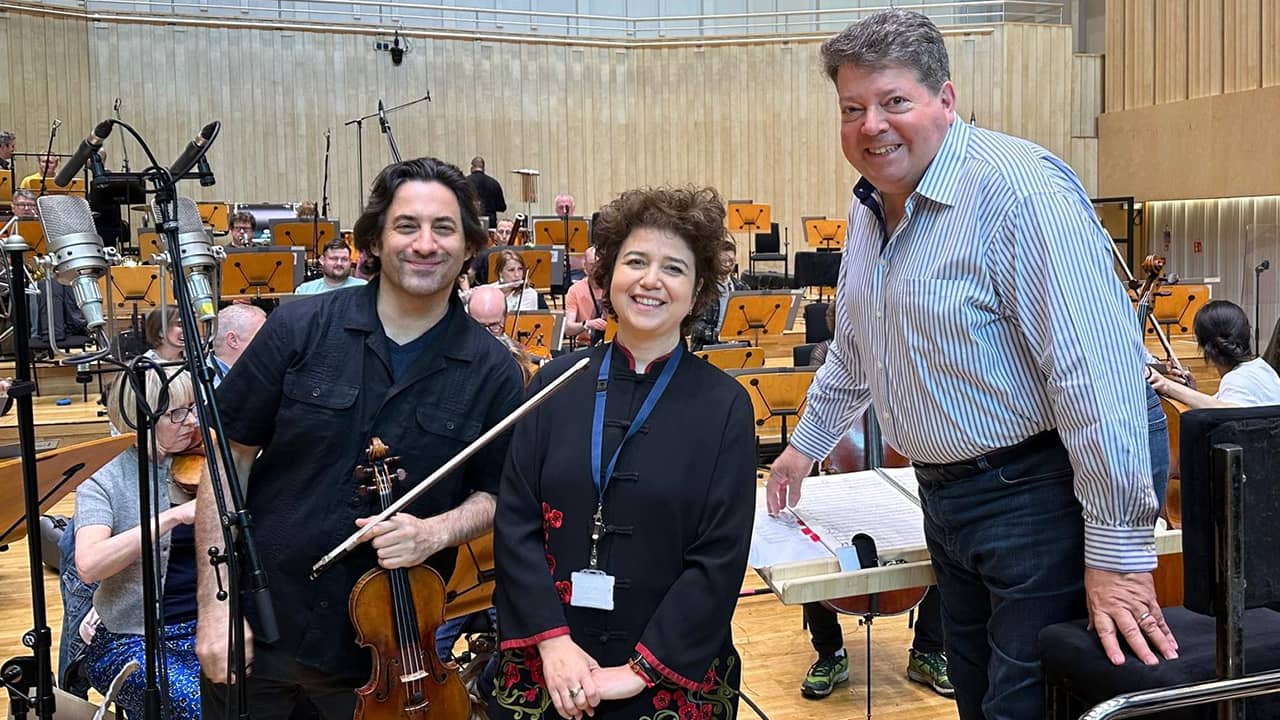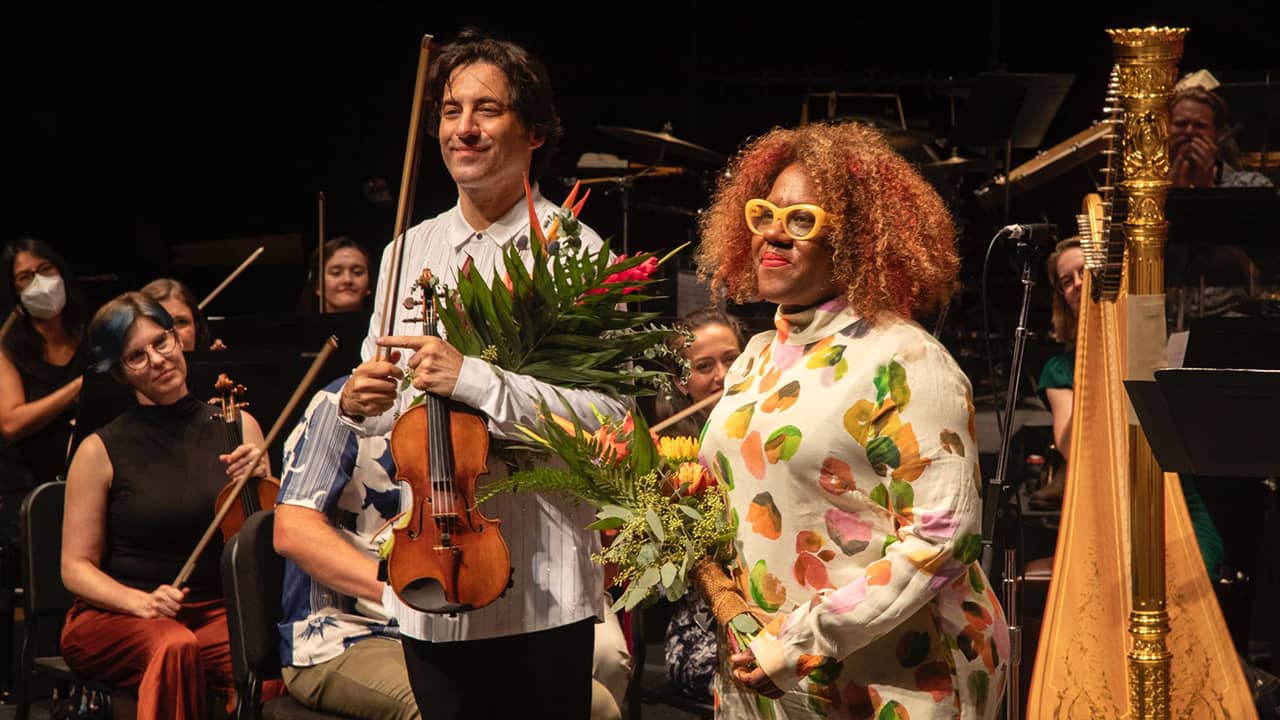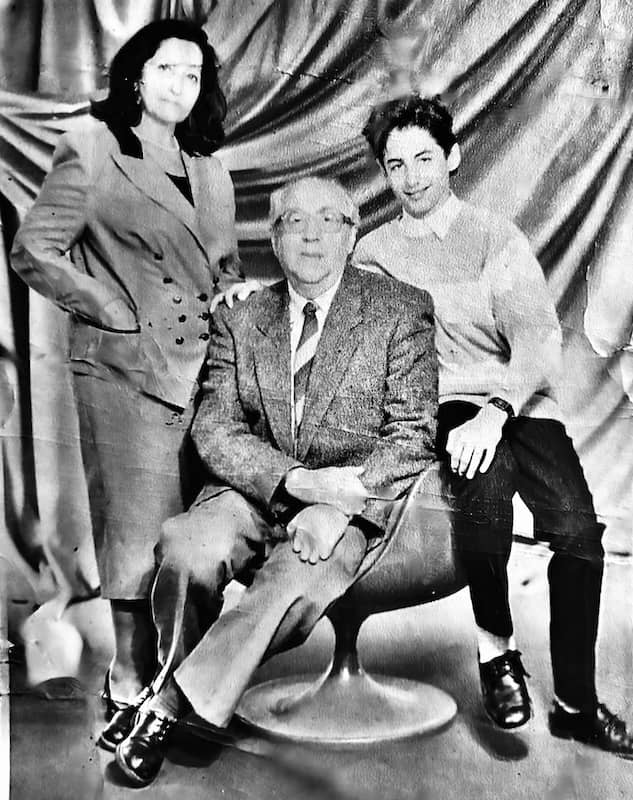Interview with Philippe Quint: Milestones and a Mother's Inspiration
It's no surprise that at least some of the inspiration for Philippe Quint's latest album, Milestones, came from the first female composer he ever knew: his own mother.
Quint's new album features celebrates three living women composers - Lera Auerbach, Errollyn Wallen, CBE and Lora Kvint. Quint performs their works, as well as Florence Price's "Adoration," with the Royal Scottish National Orchestra and Andrew Litton.
"I feel that this project was, in a way, inspired by my mother," Quint told me in an interview over the phone in late March. "She was probably my main muse to start the project."
For everyone involved, there are "milestones" of some sort. For Quint, it is "a celebration of 30 years since my professional debut, 40 years of life in music." For Soviet-born Austrian-American composer Auerbach, it’s her first large symphonic work to be commercially recorded. For British composer Wallen, it’s her first Violin Concerto.
For Soviet-born composer Kvint - Quint's mother, it’s her first major composition for violin. Kvint is known in Russia for her works for music theater, opera and film, but up until now she had resisted writing something for her famous violinist son. This recording marks their first musical collaboration, on a piece called "Odyssey" Rhapsody for violin and piano.
"I grew up in an atmosphere where women composers were not known, they were greatly suppressed by the regime," said Quint, who was born in the Soviet Union and emigrated to the United States as a teenager, to study at Juilliard. "For my mother to muscle through that saturated society, dominated mostly by men - it was extraordinary. I witnessed how she was suppressed. I witnessed how difficult it was for her - this little talented Russian girl - to bring her music and her art to the wider audiences in the Soviet Union."

Violinist Philippe Quint - at age 4, and in 2024, with his mother, composer Lora Kvint.
As a teenager, Kvint pursued her training at the Leningrad Conservatory in two majors, as a composer and as a classical pianist. "She loved the art of the song, but it was popular artists that started picking up her music, which was very surprising," Quint said. "At that time, the popular music was just taking off. The Soviet Union had their equivalent of Michael Jackson and Elvis and Madonna. These people somehow felt that they wanted to commission songs for my mom, so her songs suddenly became very popular at a very early age." Kvint also composed the first Soviet rock opera, called "Giordano Bruno," the story of heretic that believed that the earth was round - and was thus burned. "It was a huge breakthrough for her, and she was immediately commissioned more work for stage, for film, for theater," Quint said.
"It was not until a few years ago that she started to come back to writing classical music," Quint said. "For many, many years, she declined to write anything for me. She felt that she could not write anything for violin that was as great as Mendelssohn, Sibelius or Tchaikovsky. I told her, 'We have those pieces - we need a piece from you, I need a piece from you.'"
Last year he asked her to reconsider, and a little while later he received a phone call from her. She asked him if he remembered a book about the legends and myths of ancient Greece. "Of course I remembered it - it was a book that was given to me by my grandfather, which is her father," Quint said. She told him that she was reading the story about King Odysseus, and that a theme was percolating in her mind - something she thought would sound good on violin.
"I could see that there was something camouflaged in that conversation, and I could sense that she was contemplating an idea," Quint said. "I didn't push it at all, but a couple of months later, she said that 'I am in the process of completing 'Odyssey' Rhapsody for you, and it's going to be based on a story that we discussed...'"
"It has a wonderful story, and it has a little bit of a connotation of both of my mom's and my own childhoods," Quint said. "So, it's a very, very special project."
BELOW: "Odyssey" Rhapsody for Violin and Piano, by Lora Kvint.
When it comes to the two violin concertos on the album, they were both commissioned by Philippe - but more than 20 years apart. "These are two very, vastly different but very brilliant composers, very inventive and imaginative."
Philippe asked Lera Auerbach to write him a violin concerto back when the two were students in the late 1990s at The Juilliard School.
"At the time, I knew very little about what commissioning a concerto meant," Quint said. "I just remember bumping into her in a hallway and saying, 'You know, you should write a concerto for me!' She immediately agreed. We kept talking about it for the next few months. Then a certain point, we realized that in order to commission a concerto, you need an orchestra. I know it sounds like a comedy sketch! But the truth of the matter is that we were very unaware. I had heard her music, I was blown away - I wanted to play her music. We were all about music and collaboration, and there was never any other thought - only that we could work together."
Both Philippe and Lera had left Soviet Union right before the fall of the Iron Curtain in 1991, "so we had very similar experiences growing up in a very oppressive regime," Philippe said. "All of that was depicted in her music; that is why her musical language was immediately understood by me. It spoke to my heart and triggered childhood memories."

Violinist Philippe Quint, composer Lera Auerbach and conductor Andrew Litton.
On the practical side of things, they realized that it would be easier to create a sonata for violin and piano rather pushing forward with a concerto for violin an orchestra. Since Lera is a pianist, they could simply play it together, without having to find an entire orchestra. So they worked together - they had occasional "negotiations" about "violin-friendliness" - "I welcome challenges - I would always be on the side of a composer, to try to preserve their original idea," Quint said. "Only if I felt that I would need a six finger on my left hand to do something - then I would say that maybe this needs to be changed!"
When the sonata was nearly ready, they had some luck - the American Youth Orchestra and conductor Alexander Treger offered to commission a concerto from Lera. "Sure enough," Quint said, "she orchestrated the sonata, which turned into a concerto, and then we suddenly had two versions of the piece, which worked great for me."
The concerto was born, and it was premiered during the inaugural season of Disney Hall in 2003.
"It was very original in nature. It had some of the depiction of my childhood, Lera's childhood," Quint said. And let's just say - it is not a rosy picture. Front and center is the oppression, fear, even horror of the Soviet Regime - the piece starts with what Lera calls musical "death clusters" and goes from there.
BELOW: Lera Auerbach's Violin Concerto No. 1: I. Grandioso
Both Lera and Errollyn used bells in the opening of their concertos - but while Lera's are frightening, Errollyn create a more eerie atmosphere. "I must have shared with Lera, as I did with Errollyn, that when I grew up in Soviet Union, I grew up around a lot of churches, and the sound of church bells was something that was very prevalent in my childhood," Quint said. "I think both composers immediately decided to implement that - but very, very differently."
Errollyn Wallen's Violin Concerto for Philippe "is much more of an eclectic concerto," Quint said. "It goes through a hybrid of emotions and feelings." Commissioned by a consortium of six orchestras, it was premiered by Quint in March 2024 with the Calgary Philharmonic and Rune Bergmann. The other five commissioning orchestras were Kansas City Symphony, Royal Scottish National Orchestra, Brevard Music Center Orchestra, North Carolina Symphony, and Theater Magdeburg in Germany - all of whom have performed the concerto with Quint in the last year.

Philippe Quint with composer Errollyn Wallen at a performance of her Violin Concerto at the Cabrillo Festival.
"Errollyn's concerto is very distinct with each movement. The first movement is very dark and tormented, and it also has couple of quotes from Stravinsky and Bartok, which are two composers that we discussed thoroughly," he said. "The second movement...is some of the most extraordinary string writing, on par with the second movement of Barber concerto, or the slow movement, the fourth movement of Bernstein Serenade."
"It's just extraordinary writing - heart-on-the-sleeve, with great sincerity," Quint said. "And she implemented a very important song in my life, a Yiddish lullaby that my grandfather used to sing to me - 'Shlof Mayn Feygele,' or 'Sleep, my little child.' This is a song that I went to bed with for many, many years. My grandfather was probably one of the most inspiring figures in my life."

Young Philippe Quint with his grandparents, Marina and Gennady Kvint.
"The reason I'm a violinist is because of my grandfather," Quint said. "He was not a musician himself, but he raised me. Everything I know, I know from him. And he was a bit of a hero also: he lost both of his legs in early childhood, then he became a great nuclear scientist in the Soviet Union. It was not an easy task, believe me, at that time."
Wallen called the third and final movement of the violin concerto "Cheeky and lively."
"That's very Errollyn too - she can be very light-hearted, very warm, very humorous," Quint said. "That last movement has all of that. I actually feel that it's more of a depiction of her personality, within the frame of the concerto for me, and I really welcome that. The third movement is a bit of a tour de force for violin - pyrotechnics, and very challenging rhythmically. It's virtuoso writing for orchestra and for conductor. It's a fun piece to put together. Now I've done it close to 17 times with, I think eight orchestras. For a new concerto, this is almost unheard of, to have so many premieres around the world! I felt very fortunate that so many of my conductor friends and orchestras jumped on board to bring this piece to a wider audience."
While this was a project celebrating women composers, Quint feels that it is not necessary to put a point on that - these are simply exceptional composers.
"We're talking about brilliant composers who have prevailed over incredible difficulties in a society and climate that presented a lot of obstacles," Quint said. "I'm just deeply honored to have had the privilege of working with some of the most amazing composers of our time. I think we live today in very different times and very hopeful times, and that we can learn from the past move forward with a lot of optimism and hope for a better future."
You might also like:
- Interview with Philippe Quint: Chaplin's Smile - and Prolific Musical Output
- Violinist.com interview with Philippe Quint: Guardian Angels and 'Opera Breve' (2014)
- Celebrate Classical Music: Philippe Quint guest blog
* * *
Enjoying Violinist.com? Click here to sign up for our free, bi-weekly email newsletter. And if you've already signed up, please invite your friends! Thank you.
Replies
This article has been archived and is no longer accepting comments.
Violinist.com is made possible by...
Dimitri Musafia, Master Maker of Violin and Viola Cases
International Violin Competition of Indianapolis
Johnson String Instrument/Carriage House Violins
Subscribe
Laurie's Books
Discover the best of Violinist.com in these collections of editor Laurie Niles' exclusive interviews.

Violinist.com Interviews Volume 1, with introduction by Hilary Hahn

Violinist.com Interviews Volume 2, with introduction by Rachel Barton Pine







